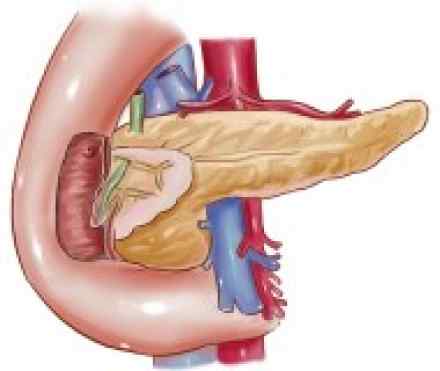
What is it?
Zollinger-Ellison syndrome is a complex condition in which one or more tumors form in your pancreas or in the upper part of your small intestine (duodenum). These tumours secrete large amounts of a hormone that causes excessive production of acid by your stomach. The excess acid, in turn, leads to peptic ulcers.
Zollinger-Ellison syndrome is rare. Less than 1 percent of duodenal ulcers result from Zollinger-Ellison syndrome. The disease may occur at any time in life, but the average age at diagnosis is 50.
Treatment for Zollinger-Ellison syndrome most often consists of medications to reduce acid and heal the ulcers. Surgery to remove the tumors may be an option for some people with Zollinger-Ellison syndrome.
Symptoms
Zollinger-Ellison syndrome causes signs and symptoms similar to those of a peptic ulcer. These may include:
- Burning, aching, gnawing or discomfort in your upper abdomen
- Diarrhoea
- Heartburn
- Nausea and vomiting
- Weakness
- Bleeding in your digestive tract
- Unintended weight loss
Causes
The exact cause of Zollinger-Ellison syndrome remains unknown. But the sequence of events that occurs in Zollinger-Ellison syndrome is clear. The syndrome begins when a tumor (gastrinoma) or tumours form in your pancreas or duodenum.
Your pancreas is located behind and below your stomach. It produces enzymes that are essential to digesting food. The pancreas also produces several hormones, including insulin and glucagon, both of which regulate blood sugar levels, as well as the stomach hormone gastrin, which controls production of stomach acid. The duodenum, the upper part of the small intestine, begins at the lower end of your stomach. In the duodenum, digestive juices from the pancreas, liver and gallbladder mix, and digestion reaches its peak.
The tumors that occur with Zollinger-Ellison syndrome are made up of cells that secrete very large amounts of gastrin, which in turn cause the stomach to produce far too much acid. The excessive acid then leads to peptic ulcers and sometimes to diarrhoea.
In addition to causing excess acid production, the tumours may be cancerous (malignant). The tumours themselves grow slowly, but the cancer can spread elsewhere — most commonly to nearby lymph nodes or your liver.
Association with MEN 1
Zollinger-Ellison syndrome may be associated with another disease called multiple endocrine neoplasia, type 1 (MEN 1). People with MEN 1 have multiple tumours in the endocrine system in addition to pancreatic tumors. They also have tumours in the parathyroid glands and may have tumors in their pituitary glands. About 25 percent of people who have gastrinomas have them as part of MEN 1.
Diagnosis
Besides reviewing your medical history and asking about your signs and symptoms, your doctor may recommend the following diagnostic procedures:
- Blood tests. A sample of your blood is analyzed in a laboratory to see whether you have an increased gastrin level in your blood. An elevated gastrin level may indicate tumours in your pancreas or duodenum. This test needs to be done on an empty stomach, so you'll have to fast prior to this test. Also, you may need to stop taking any acid-reducing medications to get the most accurate measure of your gastrin levels. Additionally, because gastrin levels can fluctuate, this test will likely need to be repeated at least three times. Elevation of gastrin can also occur if the stomach doesn't make acid, which can occur if you have chronic inflammation of the stomach or have had surgery on your stomach. This condition can be confused with Zollinger-Ellison because gastrin levels can get quite high. Your doctor may test the acidity of the stomach to clarify which condition is elevating your gastrin levels. If the stomach isn't acidic, then Zollinger-Ellison is unlikely. If your stomach makes acid, your doctor may perform a secretin stimulation test. For this test, your doctor measures your gastrin levels, and then gives you an injection of the hormone secretin. Another measurement of gastrin levels is then taken. If you have Zollinger-Ellison, your gastrin levels will increase even more.
- Upper gastrointestinal endoscopy. After you've been sedated, your doctor inserts a thin, flexible instrument with a light and video camera (endoscope) down your throat and into your stomach and duodenum to look for ulcers. Through the endoscope, your doctor may remove a tissue sample (biopsy) from your duodenum for examination in the laboratory to help detect the presence of gastrin-producing tumours. To prepare for the test, your doctor will ask you not to eat anything after midnight the night before the test.
- Imaging studies. In order to pinpoint the location of tumours, your doctor may use imaging techniques such as a nuclear scan — which uses radioactive tracers to help locate tumors — computerized tomography (CT), ultrasound imaging, or magnetic resonance imaging (MRI).
- Endoscopic ultrasound. In this procedure, your doctor examines your stomach and duodenum with an endoscope fitted with an ultrasound probe. The probe allows closer imaging of the digestive tract, making it easier to spot tumours. It's also possible to remove a tissue sample through the endoscope. You'll need to fast after midnight the night before this test, and you'll be sedated during the test.
References
http://emedicine.medscape.com/article/183555-overview
http://www.webmd.com/digestive-disorders/zollinger-ellison-syndrome
http://www.medicinenet.com/script/main/art.asp?articlekey=11423
http://www.mayoclinic.org/diseases-conditions/zollinger-ellison-syndrome/basics/symptoms/con-20024097

